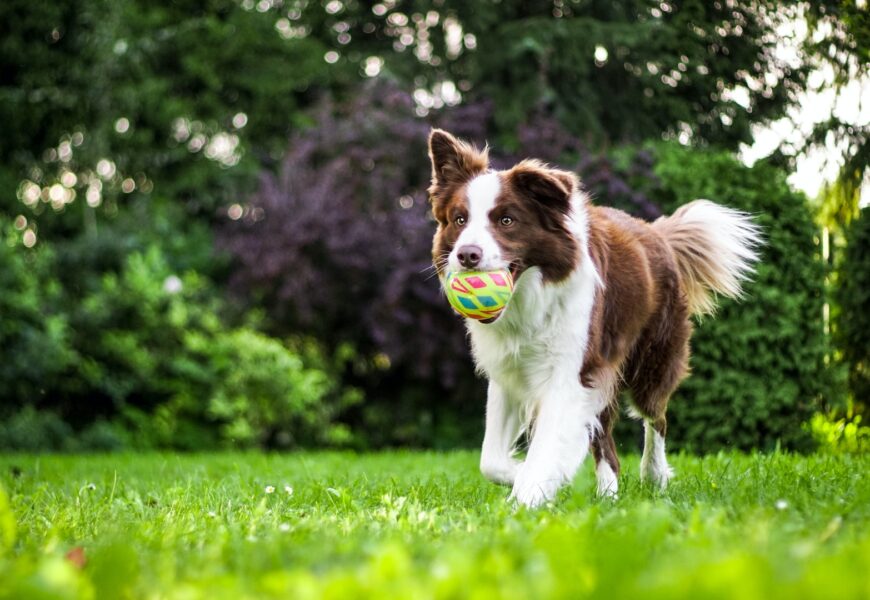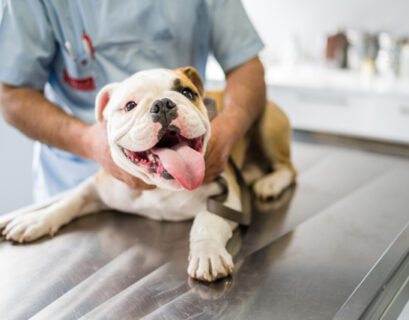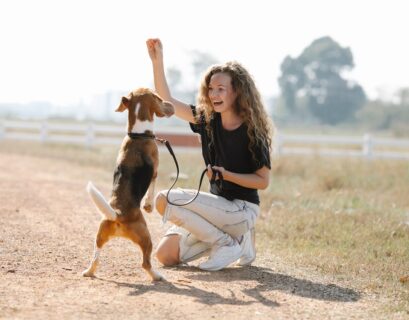“Revealing the importance of exercise and fitness for dogs: physical fitness.”
key Takeaways:
- Regular exercise is crucial for a dog’s physical and mental well-being.
- Tailor the exercise routine to your dog’s age, size, breed, and health.
- Engage in a variety of activities to keep your dog happy and stimulated.
- Set realistic goals and maintain consistency in the exercise routine.
- Monitor your dog’s weight and coat condition for signs of good health.
- Prioritize safety and avoid overexertion during exercise.
- Regular veterinary check-ups are essential for your dog’s overall well-being.
- Enjoy the journey with your dog, building a strong bond through love and adventures.
loyal companion with a wagging tail and gleaming eyes, ready for a brand new day of adventures. Your dog, a bundle of joy and endless energy, is not just a pet but a cherished family member. And just like any family member, their well-being is of utmost importance. The world of dog exercise and fitness: exploring why it’s more than just a daily stroll around the block and understanding its incredible benefits to your furry friend’s life
Don’t let our four-legged friends’ couch naps fool you—they may not join us at the gym or on the yoga mat. Dogs thrive on physical activity. Whether sprinting through the park, chasing their favorite toy, or exploring new trails, exercise is integral to their nature. But it’s not all about having fun and releasing pent-up energy; regular exercise is vital for your dog’s overall health and well-being.
In this fast-paced world where sedentary lifestyles have become common, ensuring that our canine companions get the exercise they need to stay fit and healthy is essential. But it’s not just about physical health; exercise also plays a significant role in your dog’s mental and emotional well-being. It keeps their minds sharp and their behavior in check, leading to a happier, more balanced pup.
Learn how to tailor exercise routines to fit your dog’s unique needs, considering factors like age, breed, and health conditions. The exciting world of dog sports, from agility to nose work, and discover the joy of seeing our dogs embrace their instincts while having a blast.
But exercise isn’t just a one-time activity; it’s about building a lifelong routine that strengthens your bond with your furry friend. We’ll explore the mistakes to avoid and the challenges to overcome, ensuring you and your pup can enjoy a lifetime of shared happiness and adventures.
When it comes to the well-being of our furry friends, there’s no limit to the love and care we’re willing to give.
Understanding the Importance of Dog Fitness: Keeping Your Canine in Top Shape
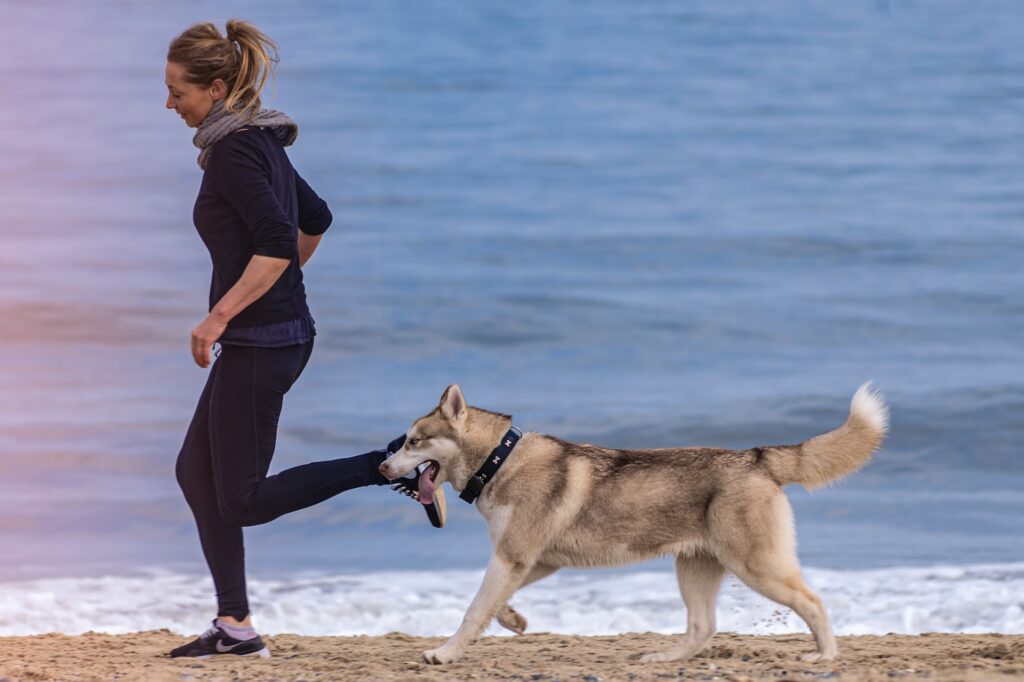
For dog owners, the sight of a happy, healthy, and energetic pup is heartwarming. The key to achieving this picture of canine bliss lies in understanding the immense importance of dog fitness. Beyond just being a fun activity, regular exercise for dogs is a fundamental aspect of their overall well-being. In this section, we’ll delve into the various dimensions of why fitness matters for your furry friend, exploring the physical, mental, and emotional benefits it brings.
A. Physical Health and Well-being
Just like in humans, physical health plays a critical role in a dog’s overall quality of life. Regular exercise is essential for maintaining a healthy weight and preventing obesity, a condition that can lead to various health problems, including joint issues, heart disease, and diabetes. By engaging in physical activities, dogs can keep their muscles toned and joints limber, promoting better mobility and reducing the risk of age-related stiffness.
Moreover, exercise helps strengthen the cardiovascular system, improving heart health and circulation. A well-exercised pup will have better lung capacity and endurance, which can lead to a longer, more active life. Additionally, consistent exercise aids digestion and metabolism, contributing to healthier eating habits and a lower likelihood of gastrointestinal problems.
B. Mental Stimulation and Behavior Management
Physical health isn’t the only aspect that benefits from exercise; mental stimulation is equally vital for a dog’s well-being. Dogs are intelligent creatures with a need for mental challenges, just like they have physical ones. Regular exercise engages their minds, preventing boredom and the development of destructive behaviors, such as excessive barking, chewing, or digging.
Engaging your dog’s mind through exercise can enhance their problem-solving abilities and cognitive skills, promoting mental sharpness and preventing cognitive decline in older dogs. Mental stimulation can come from various exercise activities, including puzzle toys, interactive games, and nose work, where dogs use their keen sense of smell to find hidden treats or objects.
C. Bonding and Relationship Building
Beyond the physical and mental benefits, exercise significantly strengthens the bond between you and your dog. Engaging in activities creates shared experiences and strengthens the mutual trust and understanding between you and your canine companion. When you partake in outdoor adventures like walks, runs, or hikes, your dog associates these experiences with your presence and positive reinforcement. This bonding process fosters loyalty and deepens the emotional connection you share with your furry friend.
Tailoring Exercise to Your Dog’s Needs: Personalized Fitness for a Happy Pup
Every dog is unique, and tailoring their exercise routine to suit their needs is essential for their well-being and happiness.
A. Considering Age, Size, and Breed
Like humans, dogs have different exercise requirements based on age, size, and breed. Puppies, for example, develop bones and joints, so high-impact activities should be avoided to prevent injuries. Instead, focus on shorter, low-intensity play sessions that allow for rest and recovery.
For larger breeds, exercise is essential to prevent obesity and maintain joint health, but avoiding excessive strain during their growth period is important. On the other hand, smaller breeds may have more energy and can engage in higher-intensity activities. As dogs age, their exercise needs may change, and activities should be adjusted to suit their changing abilities and limitations.
Understanding your dog’s breed-specific traits is also crucial. Some breeds are natural runners, while others are more inclined towards mental challenges. For instance, herding breeds may enjoy agility training, while scent hounds excel in nose work activities. Tailor the exercise routine to match your dog’s breed characteristics and preferences to ensure they are mentally and physically satisfied.
B. Health and Medical Considerations
Like humans, dogs may have underlying health conditions that can impact their exercise routines. Before starting any new fitness regimen, it’s essential to consult with a veterinarian to assess your dog’s overall health and discuss any limitations or precautions.
For dogs with orthopedic issues, such as arthritis or hip dysplasia, low-impact exercises like swimming can reduce joint stress. Dogs with heart or respiratory conditions may require a more gentle approach to exercise. In some cases, physical therapy or rehabilitation exercises can help improve their mobility and well-being.
C. Understanding Energy Levels and Preferences
Dogs have varying energy levels and activity preferences, even within the same breed. Some dogs may be content with a stroll, while others require more vigorous exercise to burn off excess energy.
Observe your dog’s behavior during and after exercise to gauge their energy levels and satisfaction. If your pup seems restless or shows signs of pent-up energy, it may benefit from
longer or more frequent exercise sessions. On the other hand, if they appear tired or disinterested, it might be a sign to scale back or try different activities.
Keep in mind that mental stimulation is just as important as physical exercise. Mixing activities that engage their brains, such as obedience training, interactive play, or hide-and-seek games, can provide a well-rounded fitness routine that satisfies their instincts.
Types of Exercise for Dogs: A World of Fun and Fitness
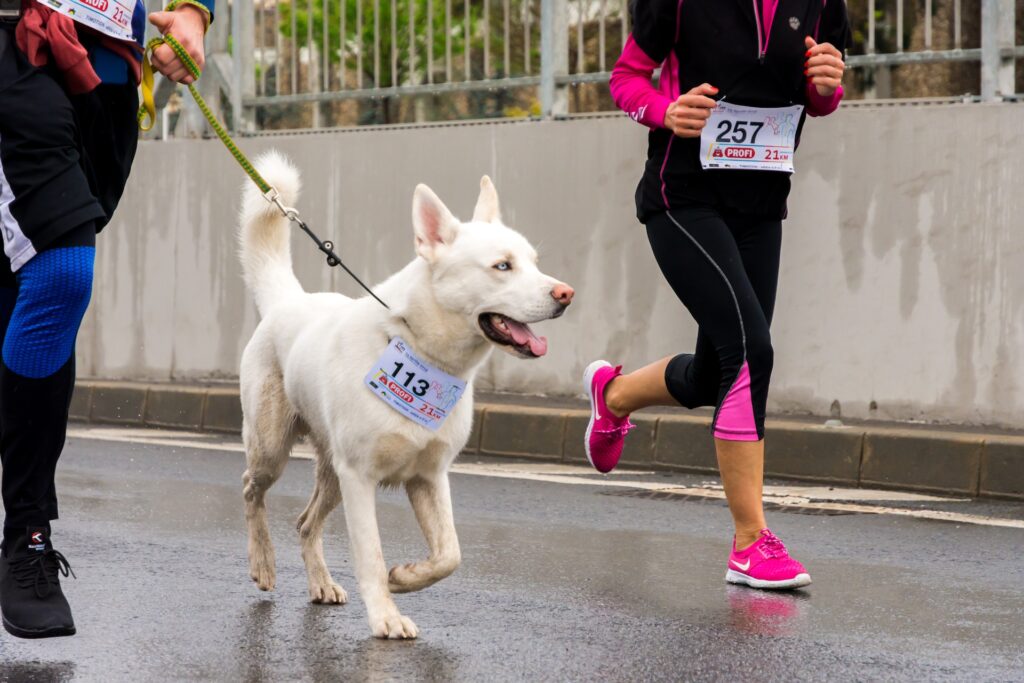
Just as humans have diverse exercise options, dogs also have many activities to keep them engaged and physically fit. In this section, we’ll explore different types of exercises that cater to your dog’s needs and preferences.
A. Aerobic Activities: Running, Fetch, and Agility
Aerobic exercises are excellent for dogs that have abundant energy and enjoy high-intensity activities. Running is a classic form of aerobic exercise that can be adapted to suit your dog’s stamina. Whether jogging beside you on a leash or letting them off-leash to race freely in a safe, enclosed area, running provides an excellent cardiovascular workout for your canine friend.
Another popular aerobic activity is playing fetch. Dogs love the thrill of chasing after a ball or toy and bringing it back to you. This game gives them a physical workout and strengthens the bond between you and your pet.
Agility training is an exhilarating sport involving guiding your dog through obstacles, such as tunnels, jumps, and weave poles. This provides a physical challenge and stimulates their mind as they learn to navigate the course.
B. Strength and Endurance Training: Hiking and Swimming
For dogs that enjoy exploring the great outdoors, hiking is an excellent activity. Hiking trails offer a variety of terrain, which helps build your dog’s strength, endurance, and balance. As they conquer hills, rocks, and uneven surfaces, their muscles and joints are exercised naturally and enjoyably.
Swimming is a low-impact exercise that is gentle on your dog’s joints while providing a full-body workout. It’s an excellent option for dogs with orthopedic issues or those recovering from injuries. Many dogs are natural swimmers; others may need encouragement and support with a canine life jacket.
C. Mental Stimulation: Puzzle Toys and Nose Work
Mental stimulation is as crucial as physical exercise for your dog’s well-being. Engaging their minds in problem-solving can tire them out mentally, making them less prone to boredom and undesirable behaviors.
Puzzle toys and interactive games challenge your dog to figure out how to access hidden treats or toys. These toys come in various difficulty levels, catering to dogs of all intelligence levels.
Nose work is another mentally stimulating activity that taps into your dog’s exceptional sense of smell. You can set up simple scent trails or participate in organized nose work classes, where dogs are encouraged to find specific scents hidden in various locations.
Creating a Dog-Friendly Exercise Routine: Building Healthy Habits
A. Setting Realistic Goals and Consistency
When creating an exercise routine for your dog, setting realistic goals that align with their age, health, and energy levels is essential. Start with shorter exercise sessions and gradually increase the duration and intensity as your dog becomes more comfortable and conditioned. Avoid pushing them beyond their limits, leading to overexertion and injury.
Consistency is key to maintaining your dog’s fitness and overall well-being. Aim for daily exercise, but be flexible and adaptable to accommodate your schedule and your dog’s needs. Even on busier days, a shorter, more engaging playtime or mental stimulation activity can make a significant difference in keeping them content and happy.
B. Incorporating Exercise into Daily Life
Incorporating exercise into your dog’s daily routine doesn’t have to be a separate or time-consuming task. Look for opportunities throughout the day to engage your pup in physical activities. For example, take a longer walk during your morning and evening strolls, and play fetch during lunch breaks in the backyard.
If you have a fenced yard, encourage your dog to run and explore freely, providing a safe and enjoyable space for them to burn off energy. If you live in an apartment or urban environment, seek out nearby parks or dog-friendly areas for walks and playdates with other dogs. Social interactions with fellow canines are physically stimulating and contribute to your dog’s emotional well-being.
C. Ensuring Safety and Avoiding Overexertion
Safety should always be a top priority during your dog’s exercise sessions. Ensure that the exercise environment is secure and free of potential hazards. Keep them on a leash when necessary, and ensure they wear proper identification tags with your contact information.
To prevent heatstroke, pay attention to weather conditions, particularly during hot and humid days. Avoid intense exercise during peak temperatures and opt for early mornings or late evenings when it’s cooler. Similarly, protect your dog from harsh weather on cold days by using a doggy coat or limiting outdoor time.
Watch for signs of overexertion, such as excessive panting, slowing down, or seeking shade. Allow your dog to rest and hydrate during exercise to prevent exhaustion. If you need more clarification about your dog’s fitness level or health concerns, consult a veterinarian for guidance.
Making Exercise Fun and Engaging for Your Dog: A Recipe for Joyful Fitness
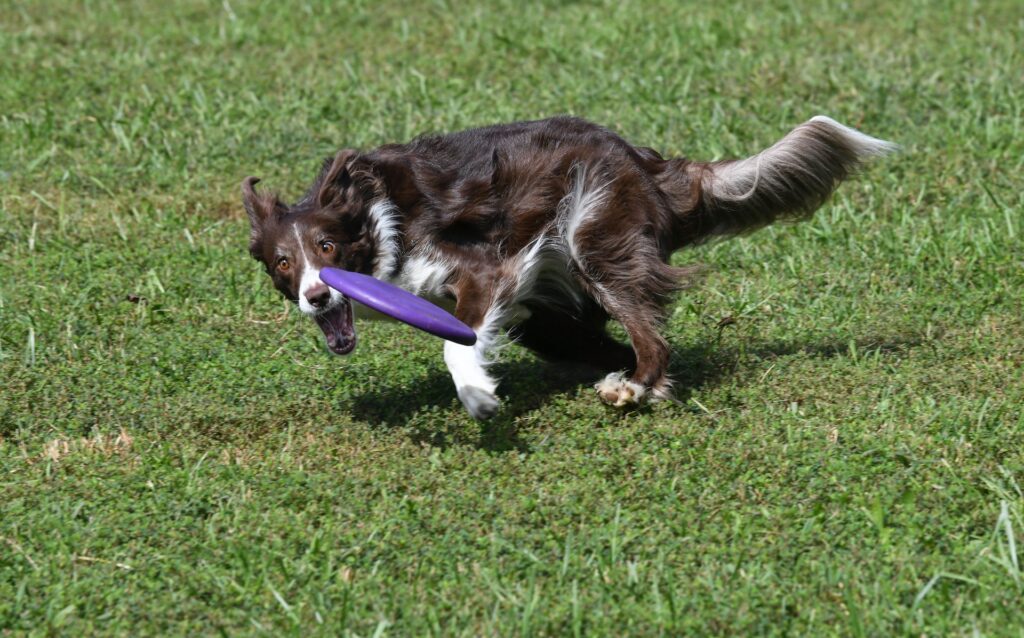
A. Incorporating Positive Reinforcement
Positive reinforcement is a powerful tool for motivating and encouraging your dog during exercise. Praise and reward them with treats, verbal cues, or affection when they follow commands or complete tasks. This positive feedback reinforces good behavior and helps build their confidence, making them more eager to participate in activities.
When playing games like fetch or agility, they use their favorite toys or treats as a reward. Associating these activities with positive experiences will make them more appealing to your furry friend.
B. Exploring New Environments and Activities
Dogs are naturally curious creatures, and exploring new environments can be exhilarating. Take your pup to different places for their exercise sessions, such as nearby parks, nature trails, or even the beach. New scents, sights, and sounds will stimulate their senses, providing mental enrichment alongside physical activity.
Introducing your dog to new activities can also add excitement to their routine. Try out different sports like flyball, dock diving, or even Canine Freestyle (dog dancing). These activities offer physical exercise and foster a stronger bond between you and your furry companion.
C. Interactive Play and Socialization
Dogs are social animals; interactive play with you or other dogs is a fantastic way to keep them engaged and happy. Playing tug-of-war, hide-and-seek, or wrestling (gently) can be enjoyable for your dog and an opportunity for you both to bond.
Dog parks or playdates with other well-behaved dogs provide valuable socialization opportunities. They get to burn off energy through play and learn valuable social skills, such as how to interact with other dogs appropriately.
Remember that not all dogs enjoy the same activities, so pay attention to your pup’s preferences and adjust accordingly. Some dogs may prefer one-on-one playtime with you, while others thrive in a group setting. Being attuned to their preferences ensures that exercise remains a delightful experience for both of you.
Signs of a Fit and Healthy Dog: Nurturing a Vibrant and Happy Companion
A. Ideal Weight and Body Condition
Maintaining an ideal weight is crucial for your dog’s overall health. An overweight or obese dog may be more susceptible to various health issues, including joint problems, heart disease, and diabetes. On the other hand, an underweight dog may lack the energy and vitality needed to lead an active and happy life.
To assess your dog’s weight, consult your veterinarian to determine its ideal body condition score (BCS). A BCS helps determine whether your dog is at a healthy weight for their size and breed. Regularly weigh your dog and adjust their diet and exercise routine to reach and maintain the optimal weight if needed.
B. Healthy Coat and Skin
A shiny and well-groomed coat indicates your dog’s overall health. A healthy diet, regular grooming, and sufficient exercise contribute to a lustrous coat and healthy skin. Look for any signs of dryness, flakiness, or excessive shedding, which may indicate an underlying health issue that requires attention.
Frequent grooming keeps your dog looking its best and helps maintain the cleanliness and health of its skin. Regular brushing removes loose fur, dirt, and debris, while bathing helps prevent skin irritations and keeps their coat free of allergens.
C. Energetic and Happy Behavior
A fit and healthy dog exudes energy and enthusiasm in their daily activities. They are eager to go on walks, play fetch, or engage in interactive games with you. An active and alert demeanor signifies a content and joyful pup.
Observe your dog’s behavior throughout the day. They should display interest in their surroundings, show curiosity during walks, and interact positively with people and other dogs. A happy dog may also wag their tail freely, have bright eyes, and display a positive attitude toward life.
If you notice any changes in your dog’s behavior, such as lethargy, loss of appetite, or unusual discomfort, consult a veterinarian promptly. Identifying and addressing potential health issues early on is crucial for maintaining your dog’s well-being.
Common Mistakes to Avoid: Nurturing a Safe and Well-Rounded Fitness Regimen
While exercise is essential for your dog’s health and happiness, it’s crucial to be aware of common mistakes that can inadvertently impact their well-being.
A. Relying Solely on Backyard Time
While allowing your dog to roam freely in the backyard can be enjoyable, it should differ from regular walks and more structured exercise. Backyard playtime may not provide the mental stimulation and social interaction your dog needs to thrive. Dogs are pack animals, and engaging with their human companions and other dogs during walks or at the park is essential to their overall well-being.
Ensure your dog has opportunities to explore different environments, interact with new smells, sights, and sounds, and socialize with other dogs. Incorporating varied activities into their routine keeps their minds engaged and helps prevent boredom.
B. Overlooking Mental Stimulation
Physical exercise alone may not be enough to keep your dog mentally fulfilled. Dogs are intelligent beings that thrive on mental challenges and problem-solving activities. Neglecting mental stimulation can lead to behavioral issues, restlessness, and depression.
Integrate brain-engaging activities into their exercise routine, such as puzzle toys, obedience training, or scent games. Mental exercises tire out your dog just as much as physical activities, ensuring they lead a balanced and enriched life.
C. Neglecting Regular Veterinary Check-ups
Regular veterinary check-ups are essential for your dog’s health, regardless of age or fitness level. Routine visits allow your veterinarian to assess your dog’s overall well-being, identify any potential health concerns, and offer guidance on their exercise and dietary needs.
During these visits, discuss your dog’s exercise routine with your veterinarian. They can help determine if your current regimen is appropriate for your dog’s age, breed, and health condition, making necessary adjustments if needed.
Remember that every dog is different, and what works for one may not be suitable for another. Tailoring the exercise routine to your dog’s needs ensures they remain healthy, happy, and thriving.
Conclusion
As we conclude our exploration of dog exercise and fitness, one thing remains abundantly clear – our furry friends deserve all the love and care we can provide. By understanding the significance of exercise in their lives and tailoring routines to their unique needs, we can create a happy and healthy environment that nurtures their physical, mental, and emotional well-being.
Exercise is not just a means to burn energy; it’s an opportunity for us to deepen our bond with our canine companions. Every moment spent together strengthens the connection between dog and owner, from leisurely walks to the park to exciting adventures on hiking trails.
As we watch our dogs thrive—with their ideal weight, shiny coat, and joyful demeanor – we know we’re doing right by them. Engaging in physical and mental activities gives them the tools to navigate life confidently and resiliently.
Yet, it’s important to remember that dogs’ ages and exercise needs may change. As a responsible pet parent, be attuned to their evolving requirements, adjusting routines and activities to accommodate their age-related limitations.
Let’s avoid common mistakes that impact their well-being. By incorporating a well-rounded fitness regimen and seeking professional guidance when needed, we ensure our furry companions live their best lives.
As we reflect on the joys and benefits of dog exercise, we are reminded of the unconditional love and boundless joy they bring to our lives. They are not just pets; they are family, and we owe it to them to provide a life filled with love, health, and adventure.
The journey of love and discovery, cherishing each moment of shared happiness, and enriching our lives through the companionship of our four-legged friends. Together, we’ll navigate the twists and turns of life, supporting each other through every step, jump, and playtime moment, making every day a delightful and cherished experience for both dog and owner alike. With love and dedication, let’s continue to nurture our dogs’ well-being and build a lifelong bond that is truly unbreakable.

